A&P II - Final EXAM Review PDF

| Title | A&P II - Final EXAM Review |
|---|---|
| Course | Human Anatomy and Physiology II |
| Institution | San Antonio College |
| Pages | 7 |
| File Size | 121.1 KB |
| File Type | |
| Total Downloads | 26 |
| Total Views | 132 |
Summary
Download A&P II - Final EXAM Review PDF
Description
AP 2402 Final Exam Review
Begin by reviewing through all past outlines for each of the chapters, given throughout the semester Use all short answer questions in previous exams to help study as well (you should have kept these after each exam was given back) Below is a step by step review for the material that needs to be reviewed for each chapter for the final exam. The information below includes the multiple choice questions that will be on the exam, along with the short answer questions.
Blood
Know the major functions of the blood TRANSPORTS oxygen & nutrients to body cells; & carbon dioxide out of the body REGULATES blood pH & body temperature PROTECTS against excessive blood loss & pathogens
Know the functions of RBCs, WBC, and platelets RBCs: (erythrocytes) transport O2 from lungs to body cells & deliver CO2 from body cells to lungs to be exhaled out of body WBCs: (leukocytes) protect the body from invading pathogens & other foreign substances Platelets: (thrombocytes) promote blood clotting
(For WBCs, be specific know what each WBC targets) NEUTROPHILS- destroys bacteria LYMPHOCYTESB cells: destroy bacteria T cells: attack infected body cells & tumor cells & are responsible for rejection of transplanted organs NK cells: attack wide variety of infected body cells & tumor cells MONOCYTES- destroy microbes EOSINOPHILS- allergic reaction or parasitic worms BASOPHILS- allergic reactions
Define hemopoiesis. Hemopoiesis – production of RBCs, WBCs & platelets within the red bone marrow
Know development of the stem cell line from a hemocytoblast to its final resulting mature cells (Ex. RBC, WBC, platlets)
Know the lifespan of a RBC in circulation 120 days
Review the various proteins located within the plasma, know the concentrations and functions of each of the proteins Transferrin – a transporter for Fe3+ in the bloodstream Ferritin – iron-storage protein
Review the different forms of anemia (Ex. Hemorrhagic anemia, aplastic anemia, pernicious anemia, iron deficiency anemia) Hemorrhagic anemia – excessive loss of RBCs through bleeding Aplastic anemia – destruction of red bone marrow Pernicious anemia – caused by inability to produce intrinsic factor needed for absorption of vitamin B12 Iron deficiency anemia -inadequate absorption, excessive loss, increased requirement, or insufficient intake of iron Megaloblastic anemia – inadequate intake of vitamin B12 or folic acid Hemolytic anemia – RBC plasma membranes rupture prematurely Thalassemia – deficient synthesis of hemoglobin
Heart
Review the chambers of the heart, note the differences between the left and right ventricles. And as to why there is such a difference
Review where pectinate muscles are located
Review the cardiac cycle (Ex. Systole, diastole) (systole = contraction, diastole = relaxation)
Depolarization of SA node atrial depolarization (P wave) atrial systole end of atrial systole [& ventricular diastole = end-diastolic volume] ventricular depolarization (QRS complex)
ventricular systole [& atrial diastole] isovolumetric contraction (pressure rises in ventricles &pushes blood up against AV valves forcing them shut. SL & AV valves are closed) ventricular ejection (SL valves open & ejection of blood from heart) ventricular repolarization (T wave) relaxation period ventricular diastole isovolumetric relaxation (SL valves close & there is a brief interval when ventricular blood volume does not change b/c all 4 valves are closed) ventricular filling
Review the Intrinsic Conduction system, be able to identify the structures in a heart diagram as well as know the function of each
Review which structure of the brain regulates heart rate Cardiovascular (CV) center in the medulla oblongata
Review the Cardiac Cycle in an Electrocardiogram be able to recognize each of the waves created 1. Depolarization 2. Plateau 3. Repolarization
Blood Vessels
Know the different forms of vessels, their function, as well as the organization from leaving the heart until the blood returns (Ex. Arteries> Arterioles> Capillaries) 1. Arteries – carry blood away from heart to organs 2. Arterioles – smaller divisions of arteries 3. Veins – carry blood from tissues back to the heart 4. Venules – smaller divisions of veins 5. Capillaries – tiny vessels where gas exchange occurs
Heart arteries arterioles capillaries venules veins heart
Review the layers of the arterial walls, know the function of each Tunica interna:
Endothelium Basement membrane Internal elastic lamina Tunica media: Smooth muscle External elastic lamina Tunica externa **veins have NO internal & external elastic lamina
Know the three different types of capillaries, their location, and their unique structural characteristics 1. Continuous capillary a. Plasma membranes form continuous tube interrupted only by intercellular clefts b. Found in: CNS, lungs, muscle tissue, skin 2. Fenestrated capillary a. Plasma membranes have many pores b. Found in: kidneys, villi of small intestine, choroid plexuses of ventricles in brain, ciliary processes of eyes, most endocrine glands 3. Sinusoid a. Endothelial cells have significantly large fenestrations, incomplete or absent basement membrane, very large intercellular clefts b. Found in: liver, spleen, anterior pituitary, parathyroid, adrenals
Review normal Blood pressure characteristics, high BP, and Low BP Males: normal = < 120/80 Females: normal = < 110/70
Define the different types of movement: Reabsorption, filtration, bulk flow, osmosis, and transcytosis, facilitated diffusion Reabsorption – pressure-driven movement from interstitial fluid into blood capillaries Filtration – pressure-driven movement of fluid & solutes from blood capillaries into interstitial fluid Bulk flow – a passive process in which large # of ions, molecules, or particles in a fluid move together in the same direction; higher pressure lower pressure
Osmosis – Transcytosis – Facilitated diffusion – Lymphatic & Immune
Define Susceptibility& Immunocompetent Know the functions of the lymphatic system Know the functions of :Complement proteins, interferons, perforins, histamines, kinins, leukotrienes, tranferrins, defensins Know the five actions of antibodies Know the signs of inflammation Review the characterizes of CD4 and CD8 cells, know which receptors are located on each, and which specific cells recognize their receptors. Know your antigen presenting cells Know the differences between the first line of defense vs. second line of defense Review the importance contributions a fever may give Know what creates the physical and chemical barriers( the first line of defense) Review passive immunity( naturally & artificially acquired) , know the draw backs of passive humoral immunity
Endocrine
Review the different types of effects that hormones can have with one another: antagonist, synergistic, permissive Know the functions of the endocrine system Define up-regulation and down- regulation Know the function of the hormones: glucagon/insulin/prolactin/ ADH Review the different types of stimulus that can trigger the endocrine system: Ex. Neural, humoral Know the function of the hypothalamus and its regulation in hormone release from the pituitary gland
Respiratory
Define the following laws: Boyles law, Henrys Law, and Daltons Law Review the structures that allow the airway to remain open Know the function of the epiglottis
Review spirometry know the differences between: Ex. TV, IRV, ERV know how to calculate lung capacities as well Be able to describe what smoking does to the respiratory system Know the primary site of gas exchange
Digestive
Know the modification that the small intestine has, to increase absorption Review the accessory organs of the digestive system, know their functions(Ex. Gallbladder, pancreas, liver) Review the layers of the GI tract, know the function and composition of each of the layers. As well as be able to know the layers from deep to superficial and vice versa Review the functions of each of the digestive system organs(Ex. Small Intestine, Stomach, Large Intestine) Review the cells of the stomach and small intestine, know the function of these cells secretions(Ex. {Parietal cells, Mucous cells, Goblet cells) Know the function of the peritoneum
Urinary
Know the functions of the urinary system Know the function of the kidneys, as well as their internal anatomy Review the function of : angiotensin II, ADH, renin Define the term retroperitoneal Review the structure of the nephrons (know the regions and functions), know the pathway of filtrate flow and formation Know the function and composition of the urinary bladder Review the flow of blood through the kidneys, be able to identify where the specific arteries lie Understand how filtration works in the glomerular capillaries Define aquaporins, and their importance
Fluid & Electrolyte
Review what composes the bulk of extracellular fluid Know the most abundant intracellular fluid: Cation/ Anion Review what are the main factors the define water loss Review the functions of electrolytes in the body Know what can cause water intoxication Review the functions of: PTH/calcitrol/calcitonin
Know how phosphates are stored in the body Review the different imbalances: alkalosis, acidsosis, alkalemia Review what can occur if there is an increase of Carbon Dioxide in the system
Reproductive
Review the pathway of sperm formation until the sperm leaves the male body Know what contributes to the formation of the ejaculatory duct Understand the function of the testes/structure, review the location as to the function Review the different structures of the female duct system, know the function Review the stages of the development of the follicles until ovulation( review the figure within your lab manual of the ovary undergoing this process) Review the uterine phase & the secretory phase Review spermatogenesis and oogenesis Know the function of the SRY gene Review the functions of these hormones: FSH/LH/progesterone/estrogen Review the characteristics and functions of the mammary glands
***STUDY HARD & BEST OF LUCK ON YOUR FINAL EXAM **...
Similar Free PDFs

AP ADMS 1000 Final EXAM Review
- 20 Pages

A&P II - Final EXAM Review
- 7 Pages

Chem Final Exam Review
- 12 Pages

Final Exam - Review notes
- 92 Pages

Bio Final Exam Review
- 2 Pages

Final EXAM Review booklet
- 5 Pages
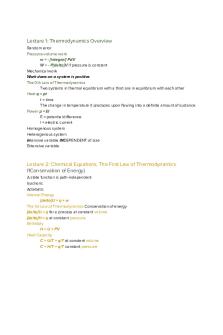
CHEM303 final exam review
- 4 Pages

Psychology Final Exam - Review
- 13 Pages
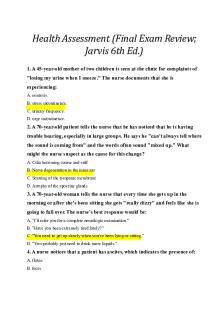
Jarvis Final Exam Review
- 12 Pages
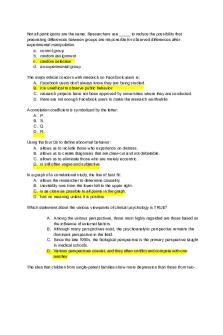
Final exam review
- 96 Pages
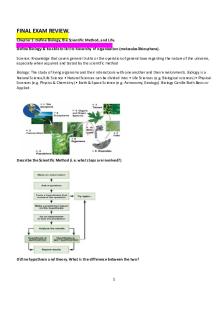
Final Exam Review
- 48 Pages
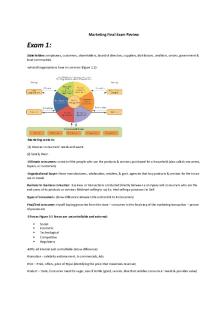
Marketing Final Exam Review
- 15 Pages
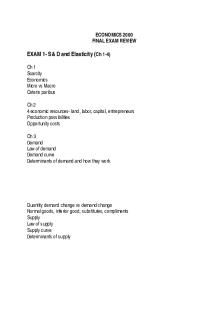
Final exam review
- 8 Pages
Popular Institutions
- Tinajero National High School - Annex
- Politeknik Caltex Riau
- Yokohama City University
- SGT University
- University of Al-Qadisiyah
- Divine Word College of Vigan
- Techniek College Rotterdam
- Universidade de Santiago
- Universiti Teknologi MARA Cawangan Johor Kampus Pasir Gudang
- Poltekkes Kemenkes Yogyakarta
- Baguio City National High School
- Colegio san marcos
- preparatoria uno
- Centro de Bachillerato Tecnológico Industrial y de Servicios No. 107
- Dalian Maritime University
- Quang Trung Secondary School
- Colegio Tecnológico en Informática
- Corporación Regional de Educación Superior
- Grupo CEDVA
- Dar Al Uloom University
- Centro de Estudios Preuniversitarios de la Universidad Nacional de Ingeniería
- 上智大学
- Aakash International School, Nuna Majara
- San Felipe Neri Catholic School
- Kang Chiao International School - New Taipei City
- Misamis Occidental National High School
- Institución Educativa Escuela Normal Juan Ladrilleros
- Kolehiyo ng Pantukan
- Batanes State College
- Instituto Continental
- Sekolah Menengah Kejuruan Kesehatan Kaltara (Tarakan)
- Colegio de La Inmaculada Concepcion - Cebu


